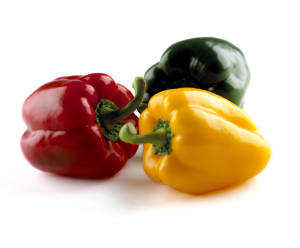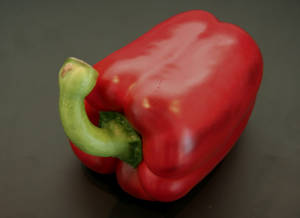This pepper is part of the Capsicum genus that is frequently referred to as a ‘bell pepper’ in North America, plainly a ‘capsicum’ in much of the English-speaking southern hemisphere and ‘sweet pepper’ in the UK. Nomenclature aside, the bell pepper is widely known as the sweet red variety, but it also comes in yellow, green, orange and purple and can taste sweet to fiery hot.
Seed packets are generally organised by color. There are many different designer cultivars to select from. They all love warmer climates including tropical ones.
Planting Bell Peppers
Select a plot that receives plenty of sunlight. Use well-drained soil. Seed is best started indoors in trays, punnets or pots of seed compost. Prick out once seedlings have formed and place in 4 inch (10cm) pots. Once they are 6 inches (15cm) tall, they can be transplanted to their final spot. They need hardening for a week or so, especially if the weather is cool. Warm weather, or more importantly warm soil, will reduce the risk of transplant shock. They should also be transplanted in the evening to avoid sun scorch.
Bell peppers should be spaced around 20 inches (50cm) apart, with rows 2 feet (60cm) apart. Smaller varieties can be planted closer together, but the above figures are safe.
Growing Bell Peppers
Bell peppers like consistently warm temperatures. They don’t take well to intermittent frost. Their growth will be limited if temperatures drop to below 15°C overnight. Moisture-retentive, free-draining soil works best, or else organic matter should be dug in before planting.
Bell peppers need regular water and plenty of fertilizer before and during the growing period. Be wary of too much nitrogen in the soil. Weeding is necessary, as always, and mulch can help keep the weeds down.
Bell peppers typically need staking to stay upright once they are about a foot tall. If possible, place the stakes in the garden bed before transplanting the seedlings so that the root system is not disrupted.
Growing Bell Peppers in Containers
Bell peppers work well in containers, and they look great as well! Use potting compost and pots of about a foot (30cm). Use a smaller variety of bell pepper. Chillies also do very well in pots. Be careful not to waterlog the compost and you should find that they grow quite easily.
Harvesting Bell Peppers
Bell peppers can be harvested at varying times using scissors to cut them from the plant. Harvest when they are green for higher yield, or wait another fortnight for them to fully ripen.
They store for a fortnight in a cool yet humid place. A room in the house is preferable to the shed or garage.
They can be frozen, but don’t do well in salads after thawing. However they can still be used in sauces and similar.
Threats to Bell Peppers
The scent of pepper is a deterrent to most bugs, thankfully. Some sneaky bugs have still managed to work their way around this natural protection (varying by continent), so keep a casual eye out for beetles, worms and fruit fly.
As previously mentioned, watch the nitrogen levels or the bell peppers may develop ‘blossom end rot’.


